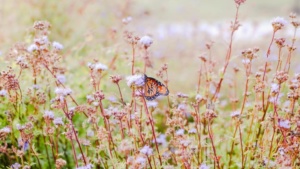 Play A Meaningful Role In The Monarch Migration
Play A Meaningful Role In The Monarch Migration
Information courtesy of College Station Parks & Recreation
At distances up to 3,000 miles, the annual fall monarch migration is among the world’s longest wildlife journeys. The butterflies travel up to 250 miles a day from their summer habitats to winter sanctuaries in the mountains of Mexico.
Waystations and pollinator gardens serve as steppingstones where the monarchs can rest and recharge along the way. Sadly, as the number of friendly stopping points has declined, the monarch population has dwindled.
Fortunately for us, the black and orange beauties funnel through the Brazos Valley from September through November. Our ideal location allows us an opportunity to not only witness but to play a helpful role in their arduous journey.
Here are some ways you can help:
Plant a Monarch Garden
If you have a bit of spare garden space, you can easily create a monarch waystation. The butterfly requires two types of plants — nectar (food for adult monarchs) and larval (food for caterpillars such as milkweed).
Research suggests that a lack of nectar plants may be a more significant factor in the monarchs’ decline than previously realized. Here are 14 nectar plants to consider for your garden:
• Black-Eyes Susan
• Zinnia
• Plumbago
• Goldenrod
• Pipe-Vine
• Purple Mist
• Passion Vine
• Senna
• Sunflower
• Hollyhock
• Purple coneflower
• Lantana
• Joe-Pye Weed
• Cassis
Vibrant colors such as red, yellow, orange, pink, and purple tend to attract adult butterflies the most, and they’re also drawn to patches of the same plant or color of flowers. Therefore, it’s a good idea to incorporate continuous-blooming annuals in islands of color or clusters of nectar plants, and it’s beneficial to include milkweed either nearby or mixed.
Don’t forget that your plants receive full sun throughout most of the day. Monarchs generally feed only in the sun.
Learn About the Monarch
We are committed to raising awareness of the monarchs’ plight and habitat needs. The Lick Creek Nature Center hosts opportunities for all ages to learn how the butterflies contribute to our planet’s health.
Saturday Exhibit Unveiling – We unveil a new exhibit with interactive activities for all ages each Saturday from 10 a.m.-noon. The displays are open throughout the week during regular operating hours. Topics feature mammals, owls, snakes, butterflies, birds, vegetation, and more. Monarch-themed days are:
Sept. 11 • “Insects of Lick Creek Nature Center”
Oct. 2 • “Monarch Mania”
Dec. 4 • “Crazy About Conservation”
Walk on the Wild Side – Walk on the wild side and enjoy a short story, hike, and playtime in Lick Creek’s outdoor classroom every Thursday from Sept. 9-Dec. 9. The program is designed for preschoolers (ages 4-6) and their caretakers. The class is from 9:30-10:30 a.m. and costs $30 per child and caretaker. Registration ends Sept. 8. Monarch-themed days are:
Sept. 16 • “Busy Bugs”
Sept. 30 • “Monarchs Journey”
Oct. 7 • “In the Garden”
Dec. 9 • “Leave no Trace”
Exploring Experiments – Kids from 7-12 years old are invited to explore nature in a stimulating, enriching, hands-on environment. We’ll discover a new topic each Friday from Sept. 10-Dec. 10 through experiments and exploration at the Lick Creek Amphitheater. The class is from 10-11:30 a.m. and costs $30 per child. Registration ends Sept. 9. Monarch-themed days are:
Sept. 17 • “Busy Bugs”
Oct. 1 • “Migrating Monarchs”
Oct. 8 • “Garden Gander”
Dec. 10 • “Conservation Heroes”
For more information, visit cstx.gov/Monarchs or email us at parks@cstx.gov.